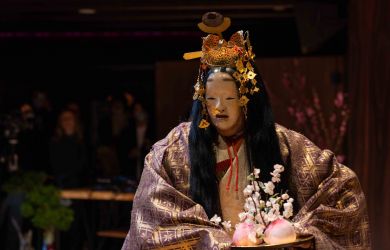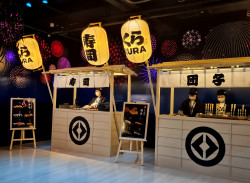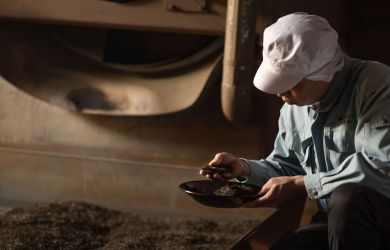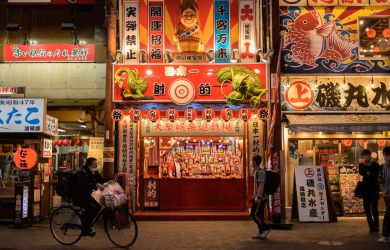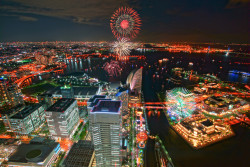
February 19, 2009
Tokyo 2050
Futuristic super-hub or graying has-been: what's next for our favorite metropolis?
By Metropolis
Originally published on metropolis.co.jp on February 2009

Paris, January 30, 2009. It’s Couture Week, and the City of Light is inundated with thousands of the world’s best-dressed power brokers, all heading to Porte de Versailles for the massive ready-to-wear trade show, Prêt a Porter Paris.
The Paris Expo center is packed with buyers, designers and journalists. Unlike haute couture, ready-to-wear is about mass consumption—high-volume, off-the-peg “fast fashion”—so being “on trend” is imperative.
Amid all the measuring and haggling, the fashionistas’ ears are pricked by the incongruous sound of a railway train, a short musical tune and then a soft female voice: Shibuyaaa, Shibuya desu.
It’s the unmistakable sound of Tokyo.
“Tokyo has never managed to place itself at the heart of the global fashion calendar, but as a source of inspiration, it’s unique,” says Nicole Fall, trend director of Five by Fifty, a Tokyo-based consumer research and trend-forecasting company. (The name refers to the projection that there will be 5 billion consumers in Asia by the year 2050.)
Late last year, Fall received a request to be Tokyo Ambassador to a “trend zone” at the heart of the Prêt a Porter show, alongside representatives from Stockholm, Rio de Janeiro, Los Angeles and, of course, Paris—selected as the world’s “New Generation Cities.”
“The new nomadic generation is stealthy, informed and connected,” says Alexandra Senes, the French creative director in charge of the trend space, whose theme changes each season. “At this time of global crisis, it’s appropriate to be looking for ideas and solutions from new places.”
Among the other ambassadors, Los Angeles is represented by GOOD, a magazine that describes itself as “for people who give a damn” (Al Gore’s son is a publisher); Rio by stylist Renata Abranchs, who recreated the city’s beach in her space; and Stockholm by the New Blood Agency of photographers.
For the Tokyo space, Fall worked with a slate of artists to create a sensory exhibit that lets visitors see, hear, touch, taste and even smell Tokyo. Among the highlights are original fragrances by scent designer Kaori Oishi that represent different parts of the city, a film by visual artist Stuart Ward, and a soundtrack by musicians Yasuharu Ohkouchi and Jeff Wichmann. In the middle of the space are five conceptual “bento boxes” filled with products from convenience stores: PET bottles of tea and other curious drinks, only-in-Japan snacks, and girly-pink cigarette boxes.

©Trevor Eccles
“One reason Tokyo leaves a unique impression on visitors is because it’s such a sensory experience,” says Fall. “Unfamiliar smells, a strange way of writing, the constant invasion of your head by noise—these are all reasons that so many people leave Tokyo feeling inspired.”
Tokyo is undeniably inspiring to many, but does this graying concrete metropolis really have what it takes to become a “New Generation City”—a global hub for the Asian Century?
Tokyo, January 30, 2050. Life is good for Taro Tanaka. The 41-year-old works for Fukuden Ltd., a Japanese nanotech company founded in 2015 that has grown into the world’s largest manufacturer of clothes that capture energy generated by human movement.
After returning from his morning run (since the fabric was commercialized in the early ’40s, Japan has become fitness obsessed!), Tanaka drops his self-cleaning nanotech tracksuit into the home battery box. The device transfers energy from the fabric into power to charge his zero-emission, crash-proof vehicle.
The introduction of the 30-hour human workweek has allowed the Tanaka family to spend more time together. They take virtual cookery classes from chefs in China and France—thank goodness their Tetsu Dai 3-series domestic helper robot speaks ten languages!
Crystal-ball gazing aside, Japan’s technological prowess should give the nation a head start in the New Generation City stakes. Automakers like Honda have already moved ahead of most foreign rivals by being first to introduce hybrid vehicles. Japanese companies like Sanyo are also world leaders in making powerful batteries and electric motors that will become more commonly used as the era of the green economy nears.
But what else will a city need to be a world leader in 2050?
“Cities that support bio and cultural diversity, urban and biological ecology, provide sustainable public transport, as well as maintaining their cultural heritage—these are the cities that will be successful in the future,” says Kristina Dryza, a designer, strategist and writer who spent most of last year in Tokyo. Dryza’s own list of cities to watch includes Singapore, Mexico City, Istanbul, Pune (India) and San Francisco.
“In 2050, Tokyo will be more integrated to the greater Asia Pacific region and highly robotized,” she says.
